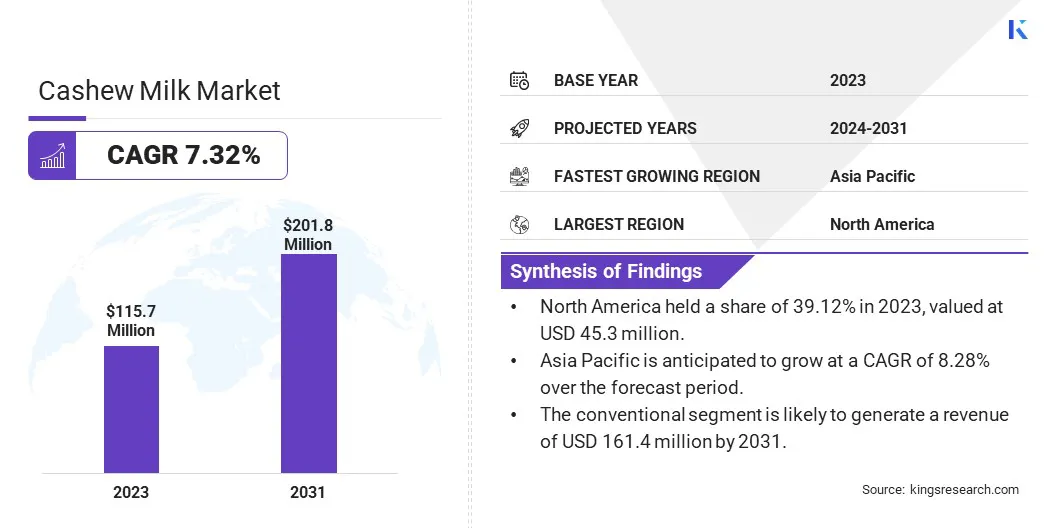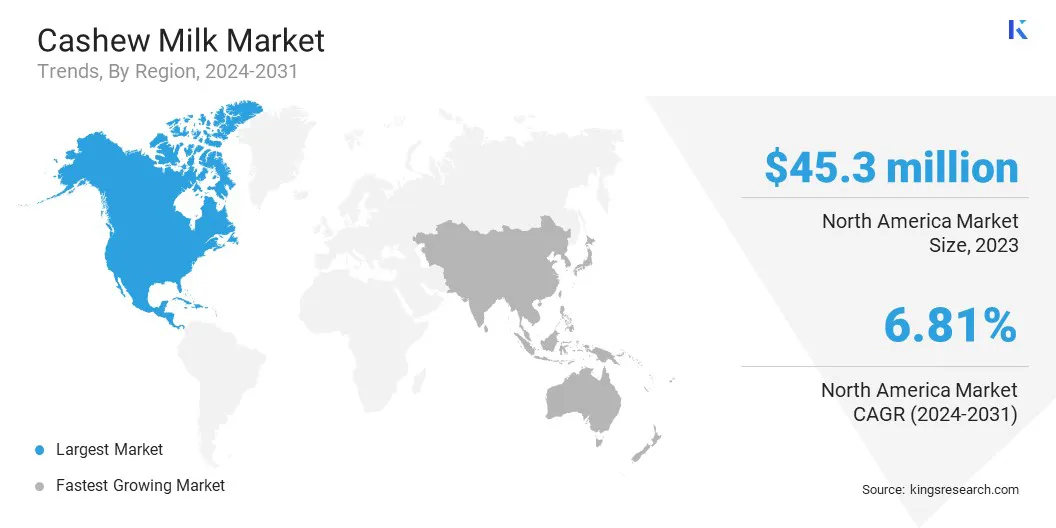Market Definition
The market comprises the production, distribution, and sale of plant-based, dairy-free beverages made from cashews, catering to health-conscious, vegan, and lactose-intolerant consumers seeking sustainable dairy alternatives.
Companies compete based on product formulation, branding, pricing, and distribution strategies. The market operates across multiple channels, including supermarkets, specialty stores, and e-commerce platforms.
Cashew Milk Market Overview
Global cashew milk market size was valued at USD 115.7 million in 2023 and is projected to grow from USD 123.1 million in 2024 to USD 201.8 million by 2031, exhibiting a CAGR of 7.32% during the forecast period.
This growth is driven by increasing consumer demand for plant-based dairy alternatives, rising awareness of lactose intolerance, and the growing preference for sustainable, nutritious beverages. Expanding product innovation, fortified formulations, and the entry of new market players further contribute to market expansion.
Major companies operating in the cashew milk industry are Elmhurst Milked Direct LLC, Forager Project, Danone North America, Pacific Foods, MALK Organics, Valsoia, SunOpta, Inc., TheGentleNut, Britvic, Nayagreens, Riverford Organic Farmers Ltd, Z Natural Foods, rude health, RITA Food & Drink Co., Ltd., and Veganday Lifestyle Pvt. Ltd.
The growing focus on plant-based functional beverages is leading to increased investments in new flavors, sugar-free options, and probiotic-infused cashew milk to cater to evolving consumer preferences. Additionally, the rise in food service applications, including cafés, restaurants, and smoothie bars, is boosting market penetration.
 Key Highlights:
Key Highlights:
- The cashew milk industry size was recorded at USD 115.7 million in 2023.
- The market is projected to grow at a CAGR of 7.32% from 2024 to 2031.
- North America held a share of 39.12% in 2023, valued at USD 45.3 million.
- The hypermarket/supermarket segment garnered USD 63.0 million in revenue in 2023.
- The sweetened segment is expected to reach USD 130.8 million by 2031.
- The conventional segment is likely to generate a revenue of USD 161.4 million by 2031.
- Asia Pacific is anticipated to grow at a CAGR of 8.28% over the forecast period.
Market Driver
"Rising Incidence of Lactose Intolerance"
The rising prevalence of lactose intolerance and dairy allergies is driving demand for plant-based milk alternatives, bolstering the growth of the cashew milk market.
As awareness grows regarding the digestive discomfort associated with lactose consumption including bloating, diarrhea, and abdominal pain, consumers are actively seeking dairy-free alternatives that provide a comparable taste and nutritional profile without adverse health effects.
Cashew milk is emerging as a preferred choice among lactose-intolerant individuals due to its naturally creamy texture, mild flavor, and compatibility with various applications such as coffee creamers, smoothies, and cooking.
- In March 2023, the National Library of Medicine reported that around 65% of the global population experiences lactose malabsorption, with the prevalence reaching 70–100% in East Asian communities. Additionally, lactose intolerance is common among individuals of West African, Arab, Jewish, Greek, and Italian descent, boosting demand for dairy-free alternatives such as cashew milk.
Market Challenge
"Limited Supply Chain"
A major challenge hindering the development of the cashew milk market is the limited supply chain, as the cashews are highly concentrated in specific regions, making it vulnerable to fluctuations in prices, climate conditions, and trade regulations. These factors can result in increased production costs, limiting the affordability and market penetration of cashew milk.
To mitigate this challenge, companies can invest in supply chain optimization by establishing direct partnerships with cashew producers, implementing fair trade sourcing, and exploring alternative processing technologies to reduce waste and improve efficiency.
Market Trend
"Product Innovation and Diversification"
Rising consumer demand for high-quality, nutrient-rich, premium, and ethically sourced functional cashew milk is boosting the growth of the cashew milk market. Manufacturers are focusing on developing new and exciting flavors to cater to a wider range of consumer preferences.
This includes introducing unique, seasonal, and dessert-inspired flavors. In addition to flavors, manufacturers are exploring different formulations to enhance the nutritional profile of cashew milk. This includes adding protein, fiber, and essential nutrients to improve the beverage’s nutritional profile.
Cashew Milk Market Report Snapshot
|
Segmentation
|
Details
|
|
By Sales Channel
|
Hypermarket/Supermarket, Online Retails, Specialty Store, Other Retails Formats
|
|
By Product Type
|
Sweetened, Unsweetened
|
|
By Nature
|
Organic, Conventional
|
|
By Region
|
North America: U.S., Canada, Mexico
|
|
Europe: France, U.K., Spain, Germany, Italy, Russia, Rest of Europe
|
|
Asia-Pacific: China, Japan, India, Australia, ASEAN, South Korea, Rest of Asia-Pacific
|
|
Middle East & Africa: Turkey, UAE, Saudi Arabia, South Africa, Rest of Middle East & Africa
|
|
South America: Brazil, Argentina, Rest of South America
|
Market Segmentation
- By Sales Channel (Hypermarket/Supermarket, Online Retails, Specialty Store, and Other Retails Formats): The hypermarket/supermarket segment earned USD 63.0 million in 2023 due to the widespread availability of cashew milk in large retail chains, which offers extensive shelf space, attractive discounts, and convenient shopping experiences.
- By Product Type (Sweetened and Unsweetened): The sweetened held 65.67% of the market in 2023, fueled by rising consumer preference for enhanced taste and flavor.
- By Nature (Organic and Conventional): The conventional segment is projected to reach USD 161.4 million by 2031, largely attributed to its affordability, wider availability, and strong consumer demand.
Cashew Milk Market Regional Analysis
Based on region, the global market has been classified into North America, Europe, Asia Pacific, Middle East & Africa, and Latin America.
 North America cashew milk market captured a share of around 39.12% in 2023, valued at USD 45.3 million. This dominance is reinforced by the growing consumer shift toward plant-based diets, rising cases of lactose intolerance, and increasing demand for dairy-free alternatives.
North America cashew milk market captured a share of around 39.12% in 2023, valued at USD 45.3 million. This dominance is reinforced by the growing consumer shift toward plant-based diets, rising cases of lactose intolerance, and increasing demand for dairy-free alternatives.
The well-established retail infrastructure, including major supermarket chains, specialty health stores, and online platforms, has further facilitated easy product accessibility and brand visibility.
Asia-Pacific cashew milk industry is estimated to grow at a CAGR of 8.28% over the forecast period. This growth is fostered by rising health awareness, an increasing prevalence of lactose intolerance, and rapid urbanization leading to changing dietary habits.
Countries such as China, India, and Japan are witnessing a growing demand for plant-based dairy alternatives due to shifting consumer preferences, influenced by health concerns and the high production of cashew nuts.
- In November 2023, the Agricultural and Processed Food Products Development Authority (APEDA), under India’s Ministry of Commerce, facilitated a cashew nut export initiative to mark National Cashew Day. This included Bangladesh’s first-ever shipment from Odisha, strengthening India’s position as the world’s second-largest cashew producer and exporter after Côte d'Ivoire.
Regulatory Framework
- In the U.S., the Food and Drug Administration (FDA) oversees the safety, labeling, and manufacturing standards for cashew milk as it falls under the category of plant-based beverages and non-dairy milk alternatives.
- In Europe, cashew milk is regulated under various EU food safety, labeling, and market regulations. The European Food Safety Authority (EFSA) is also responsible for assessing food safety risks and providing scientific guidance on nutritional standards, ingredient safety, and health claims for plant-based milk products. It evaluates novel ingredients, food additives, and potential allergens in plant-based dairy alternatives.
- In India, the Food Safety and Standards Authority of India (FSSAI) regulates the manufacturing and sale of cashew milk. FSSAI is responsible for overseeing the manufacture, storage, distribution, sale, and import of food products to ensure their safety and quality.
Competitive Landscape
The global cashew milk market is characterized by a large number of participants, including both established corporations and emerging players. Key market participants are fostering innovation and advancing product development to strengthen their position in a rapidly growing industry.
With applications spanning dairy alternatives, health-conscious consumer segments, and food service industries, companies are continuously enhancing their product offerings to meet evolving consumer preferences.
As the market experiences significant expansion, businesses are focusing on regional market penetration, tailoring their formulations to suit local taste profiles and dietary needs while scaling operations to capitalize on broader international opportunities.
- In November 2024, Comextra Majora launched Plantiq, a plant-based cashew milk available in two flavors: Original and Chocolate. Each 200ml bottle contains 17% cashew content and is enriched with vitamins A, B complex, C, D, E, K, as well as calcium and phosphorus, providing 15%-45% of daily nutritional needs.
List of Key Companies in Cashew Milk Market:
- Elmhurst Milked Direct LLC
- Forager Project
- Danone North America
- Pacific Foods
- MALK Organics
- Valsoia
- SunOpta, Inc.
- TheGentleNut
- Britvic
- Nayagreens
- Riverford Organic Farmers Ltd
- Z Natural Foods
- rude health
- RITA Food & Drink Co., Ltd.
- Veganday Lifestyle Pvt. Ltd.
Recent Developments (New Product Launch)
- In February 2023, Clean Juice launched cashew milk across all locations, featuring high quality organic ingredients in multiple flavours. This move is in line with the company's commitment to providing its customers with healthy and sustainable products.


